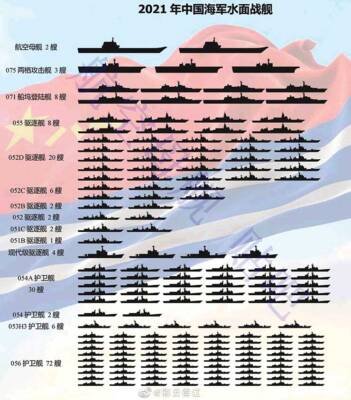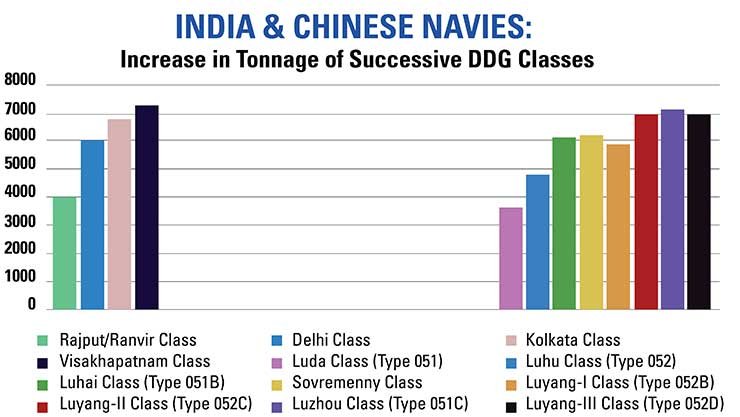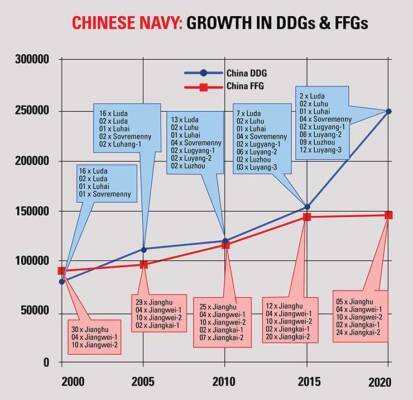
Following the incursion by China’s PLA into Ladakh in early 2020, India’s economic resources will be stretched to revive country’s economy after the deleterious effects of the Covid pandemic. India’s budget on February 1 will have to attend to the distress of the poor, but, the needs of national security must not be neglected. Security of the nation is the Sovereign’s first duty scripted into the Arthashastra.
It is also a fact of history, that the rise and fall of nations have a direct co-relation to their maritime power. If India is to rise to its potential, it has to become a recognised maritime power even if India has a powerful land Army, and a potent Air Force with a missile force and nuclear arsenal for deterrence.
 India’s security planners have to shed India’s traditional continental outlook and the Government should wisely allot funds to the Navy by scripting India’s national interests and think out challenges, especially those posed in the Indian Ocean Region (IOR) via the collusion of China and Pakistan that the Army Chief Gen MM Naravane stated on January 15 on Army Day this year. That collusion is existent and growing.
India’s security planners have to shed India’s traditional continental outlook and the Government should wisely allot funds to the Navy by scripting India’s national interests and think out challenges, especially those posed in the Indian Ocean Region (IOR) via the collusion of China and Pakistan that the Army Chief Gen MM Naravane stated on January 15 on Army Day this year. That collusion is existent and growing.
India’s nuclear arsenal does provide deterrence against nuclear neighbours and, undersea nuclear power is the best form of nuclear deterrence which is provided by India’s fledging home built nuclear powered SSBN submarines led by 6,500 tonne INS Arihant (Slayer of Enemies) with 750 km nuclear tipped K-15/ B-05 missiles, and to be followed by Arighat (Blessed attacker) this year. The Navy’s surface combatants and aerial maritime power with P-8Is provide attack and surveillance capability, and the Navy is the best form of dissuasive action against nations to project power in peace and to show the flag. That is where an aircraft carrier like a mobile airbase plays an important role.
An aircraft carrier is a valuable military instrument to project tactical air power over distances including air interdiction, anti-surface warfare (ASuW), and offensive and defensive counter-air. In operational scenarios, an aircraft carrier and SSBN submarine task forces invariably operate with submarine killer submarines (SSKs) with Air Independent Propulsion (AIP) or submerged nuclear submarines (SSNs) in the fore with missiles. India’s Navy will need both is the message of this article and funds will have to be found. (See strength of the PLA (Navy) in diagrams attached).
Lord Mountbatten, India’s Viceroy and Governor-General till August 15, 1947 who had commanded the victorious Allied South Eastern Forces in World War II and UK’s Chief of Defence Staff from 1959 to 1965, ensured that India was provided an aircraft carrier INS Vikrant with Sea Hawk fighters and Alize ASW planes in 1961 looking to the needs of maritime India. INS Vikrant played a vital part in the 1971 war in the East to hasten Pakistan’s surrender. Three aircraft carriers were included in the Navy’s first Naval Plan, as one for each coast and one in refit. But funds were never provided for the three aircraft carriers and Navy’s budget, the lowest of the three services, has waxed and waned.
Presently Indian Navy is operating 43,500 tonne INS Vikramaditya (Ex refurbished Gorshkov) with short take off MiG-29K fighters with a 14 degree ramp and recovery by wires, called a STOBAR carrier. From 1987 to 2017, the Navy operated the STOVL carrier INS Viraat combining short take-off with vertical landing Sea Harrier fighters. A 35,000 tonne STOBAR IAC-1 Vikrant is building at Cochin Shipyard Ltd (CSL) since February 2009 is awaiting sea trials. The Navy tried to design such a complicated big platform, instead of the tested Navy’s ‘leap frog’ principle to buy a design and then build future larger platforms on that design, as proved by the Leander INS Nilgiri in the 1970s bought out from Yarrow UK and the Arihant design from Rubin in Russia in the 1990s. Air Force has similarly struggled with the LCA and the Kaveri aero engine deigns and Army with the Arjun tank. China’s PLA (N) has extensively bought and copied designs and employed Russian designers.

US Navy has 11 aircraft carriers. China has two plus two more in building. UK has two and France and Italy have one each. Brazil, Russia and Korea are building carriers and navies are converting helicopter carriers to operate VSTOL F-35 JSF fighters. That is where the debate for acquisition of aircraft carriers and SSNs must begin in India as it has a direct co-relation to the Navy’s allocation of the defence budget which Admiral Karambir Singh lamented has been slashed from 18 per cent to 13 per cent after the 2017 Doklam crisis. Orders for four LPDs were cancelled and submarines delayed.
In the early 20th century the saying went; “The Sun Never Sets on The British Empire,” and it was the capability of Britain’s maritime power that included aircraft carriers that enabled it to rule its Dominion from the seas including the Indian sub-continent. Today India and Pakistan are maritime adversaries and both are endowed with maritime geography to exploit IOR and the Persian Gulf respectively, where 50 per cent of energy supplies of the world, flow.
In 1965 China settled its border with Pakistan by taking 3000 sq km of the Shaksgam Valley in Pakistan Occupied Kashmir (POK) with long term maritime ambitions to seek entry into the warm waters of the Indian Ocean, called the Great Game. China for its use has built a port at Gwadar and is constructing a submarine base at Ormara as part of the China Pakistan Economic Corridor (CPEC) and Belt and Road Initiative (BRI). China has leased a captive port and jetty in Djibouti to challenge the Indian Navy’s prominence in the IOR as the net security provider.
As of writing, the Indian Armed Forces are on alert and engaged in defending PLA’s designs in Ladakh and in Bhutan’s Doklam since 2017. China has committed to supply warships and submarines to Pakistan to vitalise Pakistan’s maritime power and may even base aircraft carriers as floating bases and submarines in the IOR. That is Indian Navy’s challenge and strategic planning must begin with allocation of funds and plans to meet it. It takes years to build ships.
India has mastered building of conventional and nuclear submarines. Professor Gabler’s Design Institute at Kiel and Lubeck in Germany and Krilov near Moscow trained officers and nuclear crews at Vladivostok. It is with this confidence the Defence Acquisition Council in 2018 sanctioned six SSNs in Atmanirbhar, that Navy believes in and Vice Admiral P Bhasin, former DG ATV nuclear submarine project, has insinuated that a SSN design can be a variant of the S-2/ Arihant SSBN minus the vertical launched missiles. The displacement can be reduced to about 4,500 tonnes. As SSNs will not be available the continued leasing of more Project 971 Akula SSGNs like Chakra makes sense. Government has not released costs of nuclear submarines but data is available with ATV and MoD which claims India makes nuclear submarines cheaper than in other countries.

Future Navy’s IAC-2 Plans Shelved
The Navy’s long term 2016 plans sanctioned US$5 million to design a large 65,000 tonne catapult- assisted take-off carrier with arrested recovery (CATOBAR). Navy began planning under USA’s Defence Technology and Trade Initiative (DTTI) in earnest. Vice Admiral SPS Cheema as FOC-in-C West took a delegation to Ingalls Huntington Yard in New Port, USA where USS Gerald Ford was being completed. Media even named the IAC-II, Vishal as the decisions on propulsion–nuclear, electric or conventional were ongoing with aircraft selection. RFIs for fighters and letters of request (LoRs) for designs to BAE Systems, DCNS, Lockheed Martin and Rosoboronexport were sent.
On May 31, 2016 Navy Chief Admiral RK Dhowan said the Government was yet to freeze the design specifications. There was even speculation that USA may sell or lease India an aircraft carrier, but that could be in the confidential regime that BJP subscribes to. Unfortunately plans for IAC-2 and funds have been shelved by MoD and no progress has been made on six SSNs or an RFP for six SSKs putting the Defence Ministry in a Catch-22 situation to choose from.
As India moves towards power status, it will increasingly come under scrutiny by regional and extra-regional actors as the world’s largest democracy to decipher India’s strategic aspirations and intentions for partnerships. The QUAD is a good indicator and on January 5, 2021 USA’s Assistant NSA Robert Obrien has declassified the 2018 Secret document titled US Strategy Framework for Indo-Pacific that depicts USA leans on India and Japan to contain China. Now eyes are on President Biden’s China policy.
In conclusion, Indian Navy needs to be taken out of the Hobson’s choice it faces between an aircraft carrier and SSNs which means the choice becomes “no choice at all.” Navy needs both and long term funds must be found.
–The writer is former DNO and DNI and Curator of IMF Maritime Museum at C-443 Defence Colony (Basement), New Delhi. He is a prolific writer and commentator on naval issues. The views expressed are his own.









